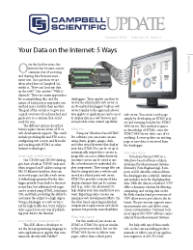Over the last few years, the Internet has become a more common way of accessing and sharing data from measurement sites. One question we are often asked here at Campbell Scientific is, “How can I put my data on the web?” Our answer? “Well, it depends.” There are many approaches for accomplishing this, and the nature of each project may make one method more suitable than another. The goal of this article is to give you a quick overview of each method and guide you to a solution that could work for you.
The different options described below require various levels of IT or web-development support. This could include providing file and FTP access, configuring web servers and firewalls, and working with HTML or other Internet technologies.
Datalogger as Web Server
Our CR1000 and CR3000 dataloggers have a built-in TCP/IP stack and, when assigned an IP address using our NL115 Ethernet Interface, they can serve web pages, just like a web server. A default page generated by the datalogger provides basic links to the most recent data, but additional web pages can be created using HTML, JavaScript, CSS, and Flash, providing the ability to customize the output to a high degree. Using a datalogger as a web server is not for high-traffic sites, but it still provides a good, low-cost way of publishing your data to the Internet.
Java Software Development Kit
This SDK allows a developer to use the Java programming language to write applications or applets that communicate directly with PakBus® dataloggers. These applets can then be served via a third-party web server or an IP-enabled datalogger’s built-in web server (similar to the approach above). Java applets or applications can be used to display data in a web browser and even provide some control capability.
RTMC Pro
Using our Windows-based RTMC Pro software, you can create screens using charts, graphs, gauges, dials, and other visual elements that display your data. RTMC Pro can be set up to automatically output these screens as image files on a user-defined interval. An entire screen can be saved as one file, or broken into its individual display components. These image files can then be integrated into a website and served via a third-party web server. RTMC Pro provides a variety of data display elements that can be customized (e.g., color, size, placement) to help display your data exactly how you want. Exporting entire screens can minimize web development efforts. On the other hand, exporting individualcomponents requires more web development, but provides more flexibility.
RTMC Web Server
For this method, you create an RTMC or RTMC Pro project similar to the previous method, but use the RTMC Web Server to deliver your pages, rather than a third-party web server. You create a web page simply by developing an RTMC project and running it under the RTMC Web Server. This method requires no knowledge of HTML, since the RTMC Web Server takes care of everything. It even updates an existing page as new data is retrieved from the datalogger.
Vista Data Vision
Vista Data Vision (VDV) is a Windows-based software solution developed by Measurement Systems (formerly Vista Engineering). It imports ASCII data files collected from the datalogger into a MySQL database and includes tools for displaying that data. With the data in a database, VDV offers a dynamic solution for filtering, comparing, and sorting data on the fly. Both standard and pro versions of VDV allow you to post data to the Internet. The pro version supports more measurement sites and allows some screen customization. Customer technical support for VDV software comes entirely from Measurement Systems.

